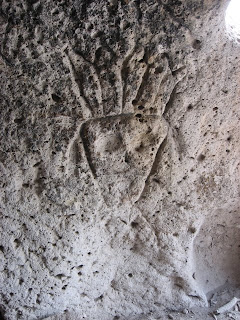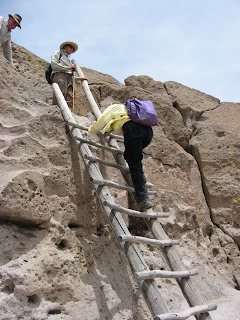
 On June 13, I had the opportunity to go on a hike with the New Mexico Museum's Friends of Archaeology to Tsankawi. This area is a detached part of the Bandelier National Monument, and an ancestral home of the San Ildefonso Pueblo. (This was my second hike with FOE; click on the link to read about my 2008 FOA trip to the Zia Pueblo.)
On June 13, I had the opportunity to go on a hike with the New Mexico Museum's Friends of Archaeology to Tsankawi. This area is a detached part of the Bandelier National Monument, and an ancestral home of the San Ildefonso Pueblo. (This was my second hike with FOE; click on the link to read about my 2008 FOA trip to the Zia Pueblo.)Our group, led by archaeologist Chuck Hannaford and ceramicist Dean Wilson, toured the trails and settlement spaces of Tsankawi. This day trip was one of three envisioned by the Friends of Archaeology for the summer of 2009 to commemorate the founding of the Museum of New Mexico 100 years earlier. Edgar Lee Hewett, an ardent explorer and champion of the Pajarito Plateau area, of which Tsankawi forms a part, would go on to serve for 40 years as Museum Director (1909-1949). This hike also echoes the anniversary of a 1909 National Geographic article describing the beautiful remote location, with its trails and cavates. (In those days, it would have taken four arduous hours to get to the Pajarito Plateau from Santa Fe!)
Tsankawi (saikewikwaje onwikege) means “village between two canyons at the clump of sharp, round cacti” in Tewa, the language of the San Ildefonso Pueblo. Settlers had first come to the plateau during the “Coalition Period” in about 1150, and lived in small family structures of 1-20 rooms. By 1250 or so, there was a pueblo with a big plaza, and by about 1325, larger villages. The area was abandoned in the middle of the 16th century (about the time of first contact by the Spanish) with its residents moving towards Cochiti and Puye.
 Archaeologist Hannaford noted three major influences on the area. First, years of volcanic eruption formed the beautiful eerie landscape. Secondly, the Ancestral Pueblo people, who lived here for 400 years, modified the land to their purposes: climbing, cultivating, building pueblos, cutting cavates (man-made caves in the soft volcanic rock), and creating petroglyph “rock art” in the cavates and on the public viewing surfaces. Finally, the coming of the scientists to Los Alamos saw further change happen--Hannaford remarked on the two vastly different realms of experience represented by the celebration of the deer dance and the splitting of the atom!
Archaeologist Hannaford noted three major influences on the area. First, years of volcanic eruption formed the beautiful eerie landscape. Secondly, the Ancestral Pueblo people, who lived here for 400 years, modified the land to their purposes: climbing, cultivating, building pueblos, cutting cavates (man-made caves in the soft volcanic rock), and creating petroglyph “rock art” in the cavates and on the public viewing surfaces. Finally, the coming of the scientists to Los Alamos saw further change happen--Hannaford remarked on the two vastly different realms of experience represented by the celebration of the deer dance and the splitting of the atom!

 We walked up trails cut deep into the volcanic rock by years of footprints, down ladders, in and out of cavates, and through the settlement areas where room block wall bases, water capture pond outlines, and numerous pottery sherds were clearly visible. We tried to imagine that the Ancestral Pueblo people were still there to watch us.
We walked up trails cut deep into the volcanic rock by years of footprints, down ladders, in and out of cavates, and through the settlement areas where room block wall bases, water capture pond outlines, and numerous pottery sherds were clearly visible. We tried to imagine that the Ancestral Pueblo people were still there to watch us. A highlight of the day featured ceramicist Wilson on his knees among the plentiful pottery sherds, pointing out the differences between the biscuit and glazed wares, and the likelihood of particular pieces of pottery being made locally or imported from other areas. He observed that some were finished with a tempera made of anthill sand, actually bits of quartz “mined” by the ants.
 We returned to our vehicles more knowledgeable about the vast Pajarito Plateau, and more conscious of the need to preserve and protect these prehistoric treasures.
We returned to our vehicles more knowledgeable about the vast Pajarito Plateau, and more conscious of the need to preserve and protect these prehistoric treasures.

4 comments:
Wonderful photos of the petroglyphs. Spectacular views. I'm curious: How does one pronounce "caveates"? My brain read cav-e-ates, but then it occurred to me it might be cave-ates, or something else.
Marilyn--it's cave-ate (and I didn't know either the pronunciation or the meaning before the hike!)
Wonderful photos and description. Bandelier is one of my favorite NM locations. It is really quite a spiritual experience to spend time there, esp. when there are few other people around.
Kate--thanks for your comment--you shamed me into getting this post up earlier! (I feel like I cheated a little--I had promised to write the trip up for the Friends of Archaeology newsletter, and then it occurred to me that I could just add the photos and make a blog post out of it.)
Post a Comment